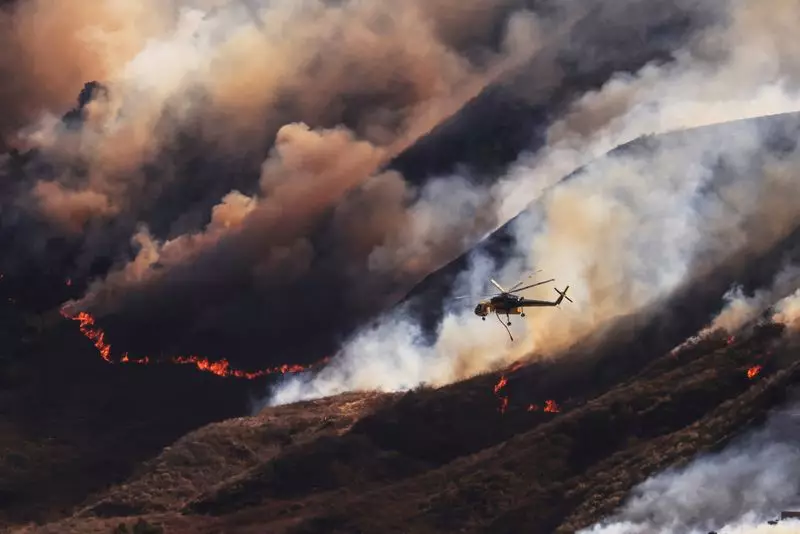As of Friday, significant progress has been made in combating the relentless Mountain Fire, located approximately 50 miles northwest of Los Angeles. The blaze, which ignited earlier in the week, has wreaked havoc on local communities, destroying at least 132 structures and damaging an additional 88. Throughout this harrowing week, firefighters have been battling challenging conditions, yet improvements in wind conditions from the Pacific Ocean have provided a much-needed respite. The firefighting efforts have escalated to about 2,400 personnel, assisting in subduing the flames that have consumed 20,630 acres of land as of Friday, with containment efforts rising from a mere 7% to 14% within a 24-hour period.
The Ventura County Fire Chief, Dustin Gardner, expressed relief at the lack of lateral fire spread on Friday, indicating a temporary stabilization of the situation. Meanwhile, evacuation orders have allowed roughly 3,500 residents to return to their homes, although about 2,000 remain under evacuation due to ongoing risks associated with the wildfire. The rugged terrain and dry brush that characterize Ventura County continue to pose significant challenges to firefighting efforts and community safety.
Personal Accounts of Loss and Survival
Amidst the extensive destruction, personal stories of survival and loss have emerged. One such account is that of Dennis Gottlieb, whose home was reduced to ashes in the chaos. Describing the rapid onset of the fire, he recounted a day that began normally but turned catastrophic when smoke began to envelop his surroundings. Despite his valiant attempts to douse the flames with garden hoses, he ultimately had to flee to save his life. Tragically, Gottlieb returned only to find that nearly all of his cherished possessions, including mementos from his life, had been consumed by fire. This narrative is a stark reminder of the human cost associated with such devastating natural disasters.
The distressing sight of homes reduced to mere chimneys speaks to the overwhelming impact of these fires on families and entire communities. Darren Kettle, another victim of the fire, shared his shock at the extensive destruction that left him and his family with nothing but memories. The emotional fallout of these events is profound, as residents grasp the magnitude of loss not merely in material terms but also in the irreplaceable essence of a home filled with personal history.
In terms of environmental factors, the National Weather Service has released updates indicating a shift in weather conditions that could aid firefighting efforts. The previously fierce Santa Ana winds, which notoriously exacerbate fire spread, have calmed down and are expected to remain manageable over the weekend. Predictions suggest wind speeds may reach a peak of 20 to 25 mph, creating a more favorable landscape for containment strategies. Meanwhile, humidity levels are forecasted to rise, potentially offering some relief to parched terrains, although the chance of rain remains distant.
Still, the respite might be temporary, as meteorologists warn that winds could pick up again by Tuesday, signalling that the dangers posed by wildfires are far from over. This fluctuation in wind dynamics showcases the unpredictable nature of wildfire management, highlighting how critical timely weather updates are for those on the frontline as well as impacted residents.
The Mountain Fire is not an isolated incident; it is part of a larger trend of increasingly catastrophic wildfire seasons in California. Climate scientists have linked soaring temperatures to the frequency and intensity of wildfires, attributing the phenomenon to shifting climate patterns. The successful combination of wet winters leading to increased vegetation growth followed by record-high summer temperatures creates an exceptionally volatile environment susceptible to ignitions.
Data from the National Interagency Fire Center underscores the severity of the wildfire crisis in the U.S., which has already recorded 8.1 million acres burned this year alone, surpassing the annual average over the previous decade. Alarming figures from Cal Fire indicate that California’s wildfire activity has reached unprecedented levels, burning over three times more land than the same time last year.
As communities grapple with the immediate fallout from the Mountain Fire and the looming future threats posed by climate change, the need for enhanced preparedness and resilience becomes ever clearer. Comprehensive strategies to mitigate fire risks and adapt to changing climatic conditions are essential in safeguarding both human lives and the invaluable natural landscapes of California. The stories of loss, sacrifice, and survival stand as powerful reminders of the imperative to confront these challenges head-on, uniting communities in a shared commitment to resilience in the face of an uncertain future.

